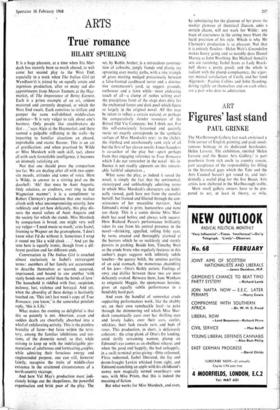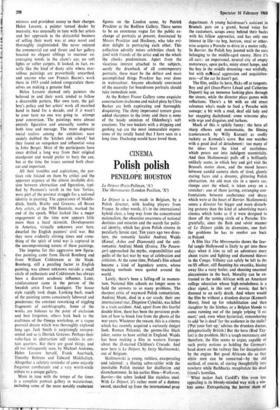Figures' last stand
ART PAUL GRINKE
The Marlborough Gallery last week enshrined a little corner of English painting and paid simul- taneous homage to its dedicated bearleader, Helen Lessore. The exhibition, entitled 'Helen Lessore and the Beaux Arts Gallery,' is part pourboire from rich uncle to country cousin, part acceptance of the responsibility for filling in the historical gaps which the Tate and the Arts Council haven't got round to, and inci- dentally a useful plug for the five Beaux Arts artists now sheltered in the Marlborough stable.
Most small gallery owners have to be pre- pared to act, at least in theory, as wife,
mistress and provident nanny to their charges. Helen Lessore, a painter turned 'dealer by necessity, was unusually in tune with her artists and her approach to the distasteful business of selling their work was at once novel and thoroughly singleminded. She never enjoyed the commercial cut and thrust and her gallery boasted no elegant siblings to murmur en- couraging words in the client's ear, no soft lights or softer carpets. It looked, in fact, ex- actly like the kind of dusty attic where mar- vellous paintings are proverbially unearthed, and anyone who saw Francis Bacon's work there in 1953 could indeed congratulate them- selves on making a genuine find.
Helen Lessore showed only painters she believed in and their work tended to follow a discernible pattern. Her own taste, the gal- lery's policy and her artists' work all marched hand in hand for a decade, and if it wasn't to your taste no one was going to attempt your conversion. The paintings were almost entirely figurative and unusually sombre in both tone and message. The more dogmatic social realists among the exhibitors were snidely dubbed the 'kitchen sink school,' but they found an outspoken and influential voice in John Berger. Most of the participants have since drifted a long way from their original standpoint and would prefer to bury the axe, but at the time the issues seemed both clear- cut and important.
All their troubles and aspirations, the par- tisan role foisted on them by critics and the apparent urgency of the almost insoluble divi- sion between abstraction and figuration, typi- fied by Pasmore's revolt in the late 'forties, were part of the postwar struggle for a national identity in painting. The appearance of Middle- ditch, Smith, Bratby and Greaves, all Beaux Arts artists, at the 1956 Biennale, marked the end of the epoch. What looked like a major engagement at the time now appears little more than a local skirmish. Developments in America, virtually unknown over here, dwarfed the English painters' civil war. But they were evidently stirring times and some- thing of the spirit of total war is captured in the uncompromising nature of these paintings.
The impetus for this aggressive new figura- tive painting came from David Bomberg and from William Coldstream at the Slade. Romberg, still a puzzling factor in English painting, was almost unknown outside a small circle of enthusiasts and Coldstream has always been a discreet academic influence. Later, reinforcement came in the person of the Swedish artist Evert Lundquist. The house style rapidly took shape. Looking back, much of the painting seems consciously laboured and ponderous; the constant reworking of niggling fragments of autobiography. Some of the works are hideous to the point of exclusion and best forgotten, others hark back to the craftiness of the Omega workshop, or a vague pastoral dream which was thoroughly explored long ago. Jack Smith is surprisingly unrepre- sented and so is Derrick Greaves. Perhaps their volte-face to abstraction still rankles in cer- tain quarters. But there are good things, and all too infrequently seen, by Michael Andrews, Helen Lessore herself, Frank Auerbach, Timothy Behrens and Edward Middleditch. Altogether a salutary reminder of some unjustly forgotten combatants and a very Worth-while tribute to a unique gallery.
More in tune with the tempo of the times is a complete portrait gallery in watercolour, including some of the more notably exuberant figures on the London scene, by Patrick Procktor at the Redfern Gallery. There seems to be an enormous vogue for the public ex- change of portraits at present, dominated by Messrs Procktor and Hockney, who take evi- dent delight in portraying each other. This collection adroitly mixes celebrities cheek by jowl with friends of the artist and on the whole the cheeks predominate. Apart from the vicarious interest attached to the subjects, surely the drawback of all contemporary portraits, these must be the deftest and most accomplished things Procktor has ever done in watercolour. Anyone absolutely convinced of the necessity for boardroom portraits should take immediate note.
At the Robert Fraser Gallery some exquisite constructions in chrome and nickel plate by Clive Barker are both captivating and thoroughly disquieting. The shiny impersonal texture gives added sharpness to the irony and there is none of the heady animism of Oldenburg's soft creations. The two buckets with a dripping and gushing tap are the most immaculate expres- sions of the totally banal that I have seen in a long time. Duchamp would have loved them.



































 Previous page
Previous page